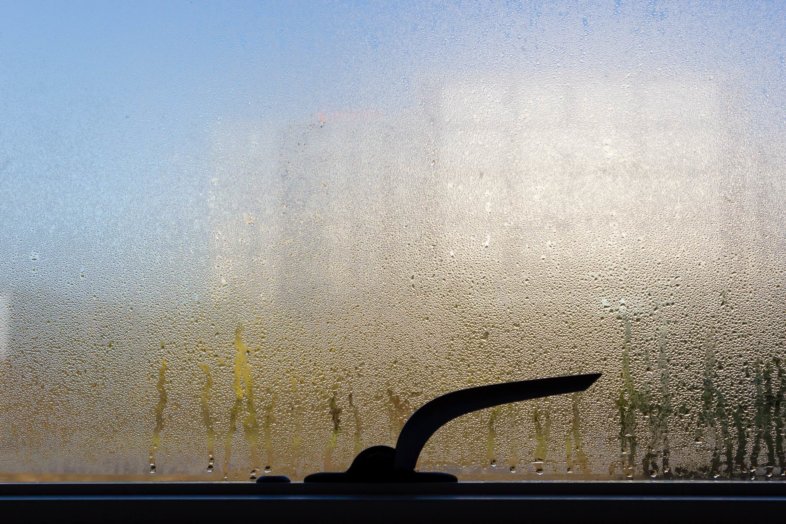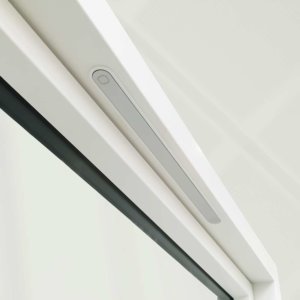A good indoor climate
In order to ensure a healthy living environment in your home, it is important that there is plenty of daylight, healthy humidity, good ventilation possibilities and, not least, measures that minimise the risk of overheating individual rooms.
Keeping a good and healthy indoor climate avoids the risk of condensation on the inside of the pane, which can eventually result in harmful mold, rot, etc.
It should be noted that whilst external condensation can occur on Idealcombi windows in autumn, winter and spring, internal condensation is rarely seen due to the high internal surface temperature of the windows.
Internal condensation
If you do not ventilate your home, you run the risk of accumulating moisture in the air that condenses on cold surfaces which is usually the inside of your windows. Once the condensation has formed, it does not help to then vent or turn up the radiator – the water should be wiped away with a cloth.
If the water is not removed, there is a risk of mold forming in the wet areas and eventually the timber can rot. Molds are harmful to health and the symptoms of an unhealthy and humid indoor climate are typically coughs and headaches, irritated eyes and, at worst, rashes and respiratory allergies.
External condensation
Condensation on the outside of windows is a phenomenon that has only occurred in recent years and typically occurs in the autumn and spring months and most often at night and in the mornings. This is quite natural and is due to the fact that the glazing today has such good insulating properties that the temperature on the outside of the window is very low. Thus, heat is not transferred from the room to the surroundings.
External condensation does not damage your windows, and you might consider it ‘a positive problem’. External condensation on the window, only affects the view and disappears quickly when temperatures increases early in the day.

Causes of moisture in the air
People
Adults add 2 litres of fluid to the surroundings in 24 hours and are therefore a major factor in the moisture calculation. The more people in the home, the greater the need for ventilation.
Drying clothes
It is tempting to dry your clothes indoors, especially in winter, but avoid drying your clothes inside as far as possible. If it is necessary anyway, be sure to vent at the same time, if possible leave a window in TurnPlus vent position. Also, make sure the hot, moist air from the dryer is vented out of the house and not inside.
Showering and cooking
Both showering and cooking exhale a lot of moisture, so it is important to keep ventilation or the extractor fan running both during and 10-15 min. after showering or cooking. The extra minutes of subsequent venting make a big difference in humidity.
Plants
Plants provide moisture and are good for a healthy indoor climate, but the more plants the greater the need for ventilation.
Dense curtains and deep window sills
Dense curtains and deep window sills can create pockets of stagnant air by the window. The air cools more easily against the cold pane and condensation forms. Pull the curtains aside during the day so the stagnant air can be replaced.
How does condensation happen?
Condensation occurs when warm, humid air cools and reaches its dew point. If the air is cooled further, condensation will form, which will typically settle on cold surfaces. In houses, the coldest surface in the rooms will typically be the glass pane of the windows, which is why it is most common to find internal condensation on windows.
Therefore, in order to circumvent the problem of condensation, it is important that the relative humidity of the home is kept at a reasonable level – max. 45% at a room temperature of 20° C
How to avoid condensation on your windows?
It is all about limiting the humidity in the air in your house. By following a few simple rules, you can create a healthier and more comfortable indoor climate, avoid condensation and, last but not least, avoid the risk of mold forming, which typically occurs where the moisture is allowed to sit for a long time.
 Air your home several times daily
Air your home several times daily
Just 5-10 minutes, 2-3 times a day. In such a short time, furniture and walls do not have a chance to cool down, so it does not have any significant impact on your heat consumption. Feel free to create a draught by opening both a door and a window – the hot humid air is quickly replaced by cool and dry air. Pay particular attention to the ventilation in bedrooms and bathrooms where moisture builds up. If you have built-in trickle vents in your windows, leave them open for fresh air circulation.
Let the air circulate from room to room
Keep the air moving by keeping your internal doors open. The humidity is then allowed to level out across all rooms as it accumulates. Stagnant air condenses more easily and therefore there is a greater risk of condensation in small enclosed spaces.
 Keep your vents clear
Keep your vents clear
A typical problem, that many overlook, is covered vents. It can be cobwebs and dust, and it can even be wasp or bird’s nests.
Make sure to keep your vents free of dirt and debris so that they work as intended.
Keep the same temperature everywhere
Many homeowners keep different temperatures in different rooms, eg. Low temperature bedrooms vs. living rooms with a higher temperature. In the cool rooms, the moisture will condense on the windows as the air cannot carry as much moisture as in the warm rooms. If possible, keep the same temperature throughout your home, 20-21ºC, but if it is a necessity for your well-being to sleep cool, then ventilate extra thoroughly in your bedroom. Even a brief drop in temperature for the night can cause condensation.
[helpful]
